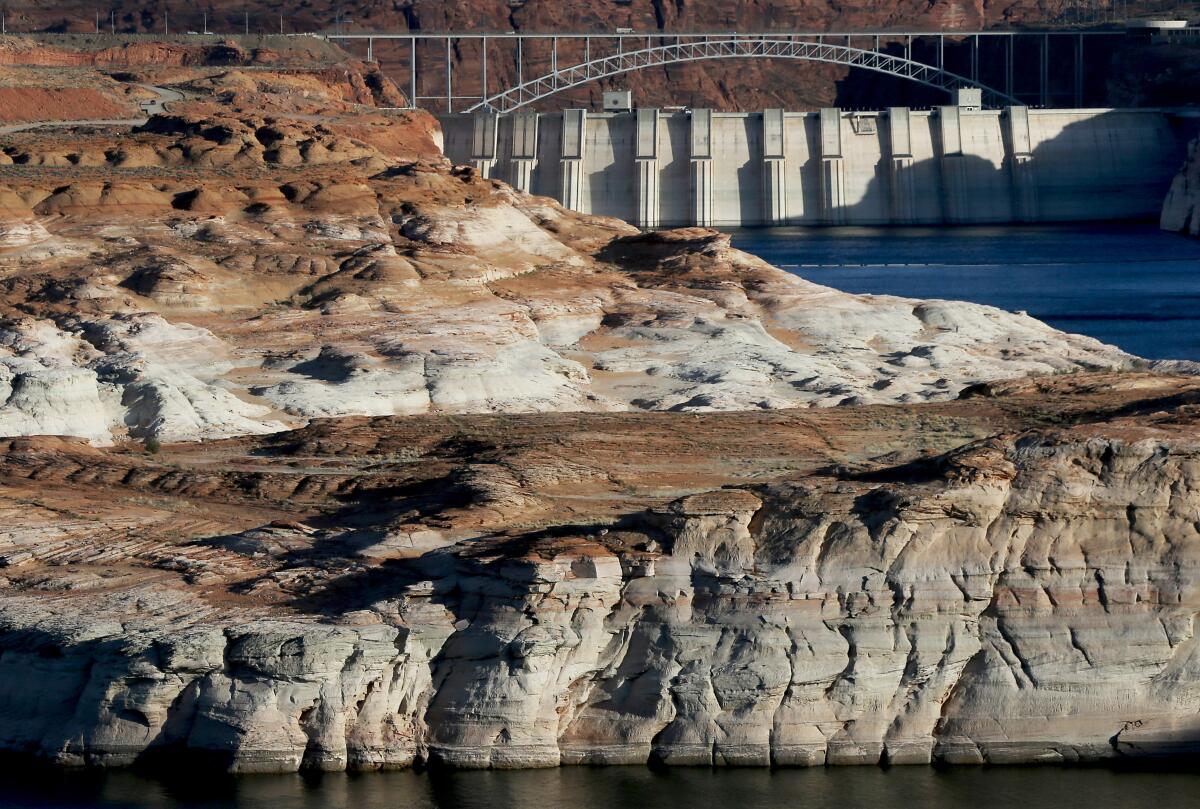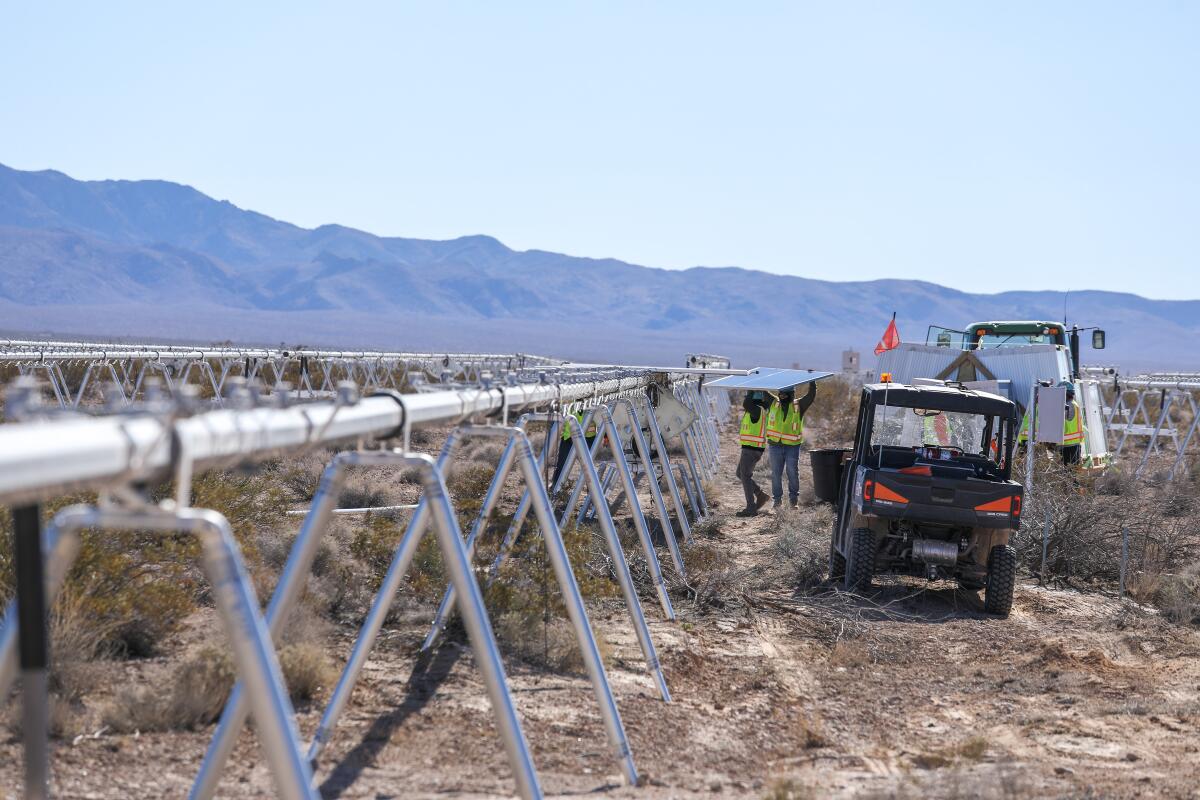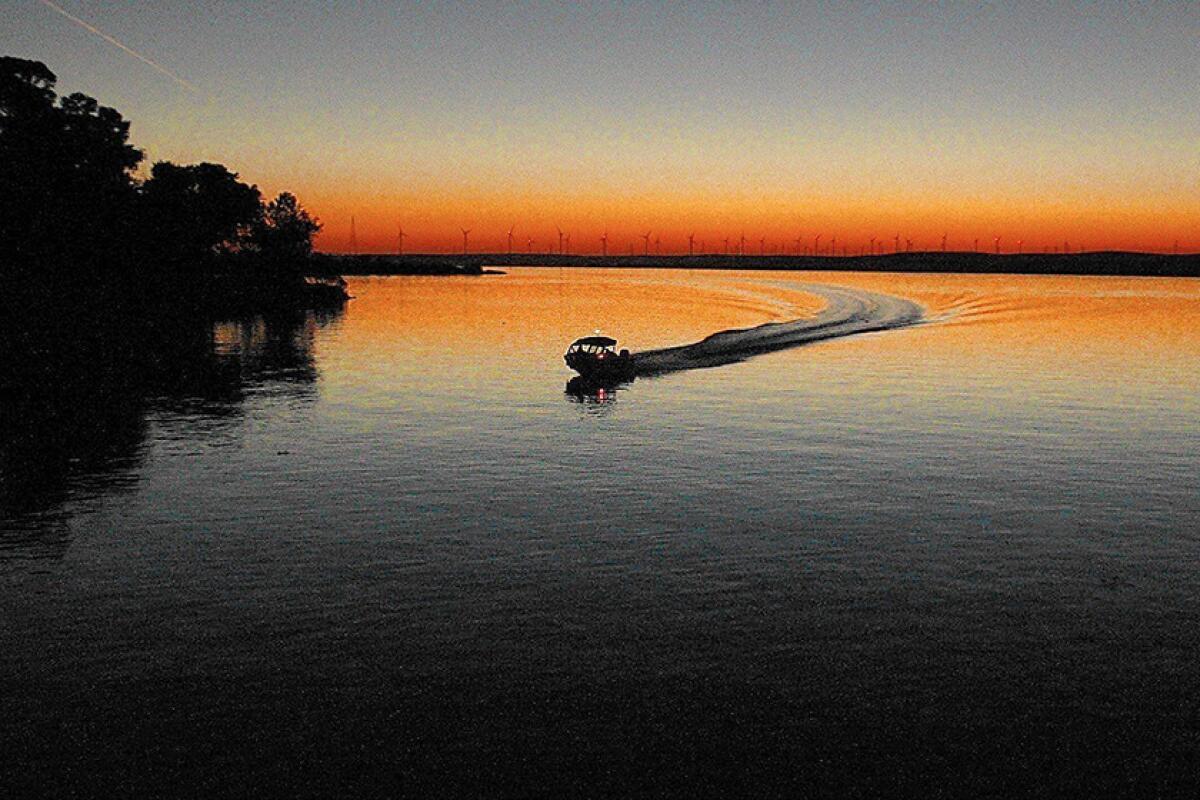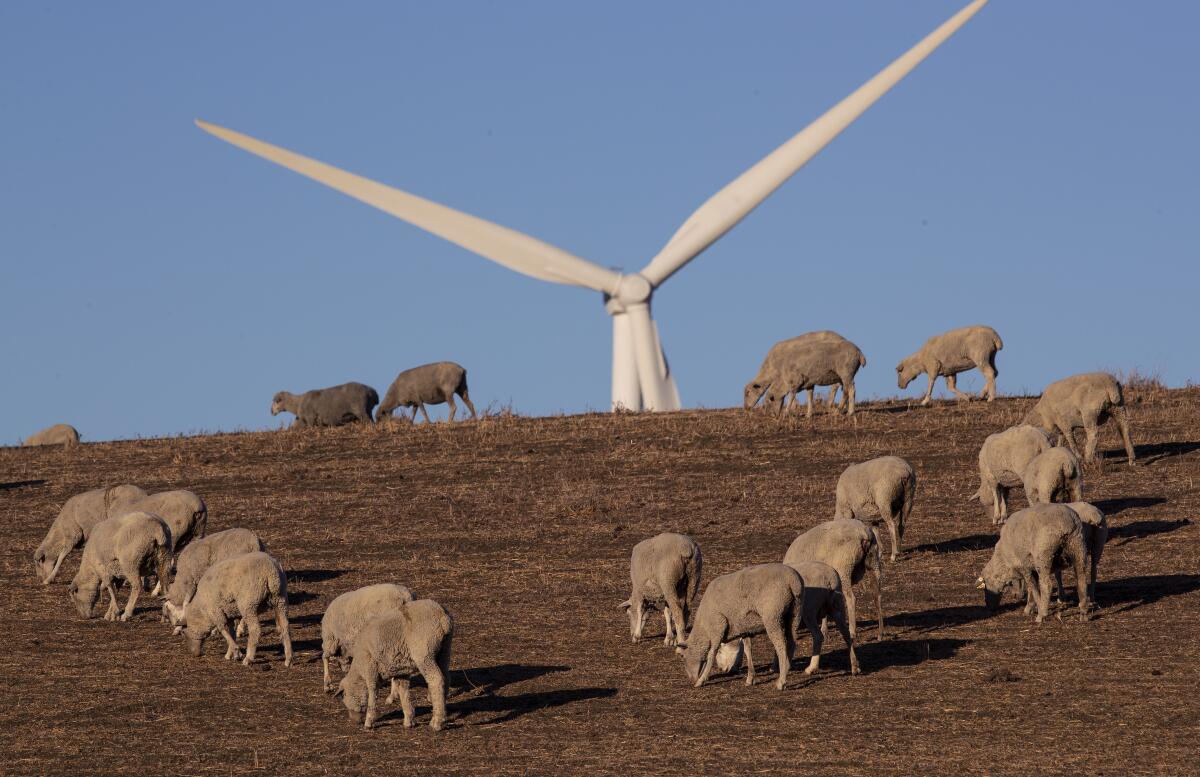Boiling Point: Are dams good or bad?

- Share via
The latest forecast has arrived for the West’s largest reservoir — and, stop me if you’ve heard this one, it’s not great.
Federal scientists are projecting that Lake Mead — created by Hoover Dam, which interrupts the Colorado River not far from Las Vegas — will fall close to its lowest level ever by the end of 2025, as the Las Vegas Review-Journal’s Alan Halaly reports. That could mean additional water cutbacks for cities and farms in California, Nevada and Arizona.
The future’s not set in stone. Even as the world continues to warm, it’s hard to predict exactly how hot or dry each year will be. There’s still plenty of short-term uncertainty and variation. Maybe we’ll get a lot more rain and Lake Mead will rise.
We’ll have to wait and see what happens — for the water in our reservoirs, and for the electricity that water generates.
You're reading Boiling Point
Sammy Roth gets you up to speed on climate change, energy and the environment. Sign up to get it in your inbox twice a week.
You may occasionally receive promotional content from the Los Angeles Times.
As it happens, a few days after the feds released their Lake Mead forecast, I stumbled across “Circle of Life,” a 12-minute film that aired at Walt Disney World’s Epcot theme park from 1995 until 2018. The film featured footage of Hoover Dam’s upstream cousin, Glen Canyon Dam, which creates the West’s second-largest reservoir, Lake Powell, along the Arizona-Utah border. The footage was part of a story in which Timon and Pumbaa from “The Lion King” are reprimanded by Simba for damming a stream.
This wasn’t the first time Disney World had used Glen Canyon Dam to emphasize the environmental harms of blockading rivers. The film that “Circle of Life” replaced — “Symbiosis,” which aired at Epcot for 12 years — featured the same footage.
As a big Disney fan who pays close attention to environmental themes in the company’s storytelling, the films were fascinating for me to watch — especially given how the conversation surrounding dams and hydropower has evolved in recent years.
Letting rivers flow free has long been a core principle of the environmental movement. But as I reported after a trip to Idaho last year, some environmentalists are reevaluating their stance on dams, given that hydroelectric turbines don’t contribute to climate change. The more dams stay up, the fewer solar and wind farms we’ll need to build to replace fossil fuels.
Don’t get me wrong: There are still plenty of folks dedicated to tearing down dams and restoring free-flowing rivers.
But the discussion is more complicated than it once was. The activists working to breach Glen Canyon Dam must contend with electric utilities who say the power it produces is crucial for providing reliable, affordable, climate-friendly energy.
I’m not expecting Disney World to feature that debate in its next attraction. I was actually thrilled when I visited last summer to see climate change featured in the film that replaced “Circle of Life,” called “Awesome Planet” and narrated by “Modern Family” actor Ty Burrell. It spotlights the worsening heat waves, wildfires, storms and droughts brought by global warming.
Maybe hydropower will help us limit those dangers. But we can’t ignore the damage dams have done, either.
On that note, here’s what’s happening around the West:
TOP STORIES

The Biden administration is out with a proposal to speed up solar-farm permitting on 22 million acres across 11 Western states — while also protecting 139 million acres of public lands from solar development. I’ll have more on this story in a few weeks; for now, the Arizona Republic’s Brandon Loomis has a good overview. The Nevada Independent’s Amy Alonzo took a look at what the proposal would mean for the Silver State specifically. Elsewhere on Western public lands, Jake Bolster wrote for Inside Climate News about the conflict between fossil fuel extraction and conservation on millions of acres in Wyoming.
California lawmaker Dave Min has introduced a bill that would ban California utility companies from spending customer money to fight climate action. The state senator, a Democrat from Irvine, crafted his legislation in response to Sacramento Bee reporting showing how Southern California Gas Co. had attempted to spend ratepayer dollars to block climate and clean energy policies — a great reminder of the power of local journalism. You can check out the Bee’s earlier reporting, by Ari Plachta and Joe Rubin, here and here. Also see my own previous reporting on SoCalGas’ use of customer money.
As climate change drains Western water supplies, mining companies are looking to tap large amounts of groundwater to help extract lithium and other critical minerals. Those minerals are needed for electric-car batteries and other climate-friendly energy technologies — but their extraction could worsen water shortages, a tension that Wyatt Myskow explores in this story for Inside Climate News. And speaking of water shortages, the New York Times’ Raymond Zhong reports that it took California water regulators several months to realize farmers had drained dry several miles of the Merced River, which is absolutely wild.
THE ENERGY TRANSITION
A major renewable energy developer attempted to intimidate Washington state officials into ignoring potential harms to Indigenous cultural sites from a proposed solar farm. That’s the key takeaway from this investigation by B. ‘Toastie’ Oaster for High Country News. Similar conflicts between tribes and the solar industry are increasingly prevalent across the West — and the same has been true of the fossil fuel industry for decades. Also in Washington, for instance, the Lummi Nation is trying to figure out why oil giant BP just bought 1,100 acres sacred to the tribe, the Seattle Times’ Isabella Breda reports.
The Biden administration has finalized approval of $1.1 billion to help Pacific Gas & Electric continue operating the Diablo Canyon nuclear plant past 2025, the Associated Press reports. No big surprises here; federal officials had been forecasting the move for months, as I’ve reported previously. The argument for keeping nuclear plants open longer is that unlike solar and wind farms, they can generate power around the clock. If it were up to many red-state lawmakers, though, we’d just keep burning coal. Just look at Utah, where the Salt Lake Tribune’s Tim Fitzpatrick reports legislators are making another effort to seize control of the coal-fired Intermountain power plant from the city of Los Angeles, which intends to stop burning coal there.
Why doesn’t the media doesn’t cover constant oil and gas spills like it does occasional wind-farm malfunctions? Western environmental journalist Jonathan P. Thompson poses that question in his latest Land Desk newsletter, before breaking down the numbers showing just how often fossil fuel pipelines spew harmful pollution. “If the media paid as much attention to oil and gas mishaps as it did to clean energy calamities, it wouldn’t be able to cover much else,” Thompson writes. He also links to my recent column about research suggesting fracking is worse for birds than wind turbines are.
WATER IN THE WEST

In a blow for Gov. Gavin Newsom’s Delta tunnel project, a judge has ruled the state can’t issue bonds to fund the project. Here’s the story from Courthouse News Service’s Alan Riquelmy. The project’s supporters say tunneling beneath the Sacramento-San Joaquin River Delta would make it easier to send water to Central Valley farms and Southern California cities without harming salmon and other Delta fish; critics say the tunnel would harm Northern California waterways by allowing a lot more water to flow south. Not surprisingly, environmental groups are suing to try to block the tunnel, Aly Brown reports for Bay City News.
“When do you get labor icon Dolores Huerta attacking a press conference attended by NAACP leaders?” That’s the question raised by this fascinating edition of Politico’s California Climate newsletter, which focuses on a newly introduced bill in Sacramento that supporters say would help bring clean water to communities of color, but which critics — including Huerta — worry would be used to advance a proposal by Cadiz Inc. to pump groundwater from beneath the Mojave Desert and sell it to Southern California cities. For more background on Cadiz, see this 2021 story by my L.A. Times colleagues Alex Wigglesworth and Ian James.
A San Diego County drinking water reservoir could be the first in the U.S. to install floating solar panels. In case you think there’s any type of renewable energy project that can get built without at least some opposition, please let this story by Voice of San Diego’s MacKenzie Elmer dispel your illusions. But it’s encouraging to see more water agencies begin to study floating solar, which, as I’ve written previously, could reduce — although certainly not eliminate — the need for big desert solar farms.
AROUND THE WEST

The tech billionaires who spent years secretly buying up land in Northern California’s Solano County are now gathering signatures for a ballot initiative that would help them build what they say would be a sustainable, solar-powered city. My L.A. Times colleague Jessica Garrison has details, writing that the California Forever community would feature “tens of thousands of new homes, along with crisp new parks, bike lanes, open space and a solar farm.” Environmental critics are unpersuaded, with the former chair of the local Sierra Club chapter saying, “We don’t think we need housing on agricultural land.”
The Biden administration has announced steps to make it easier for survivors of wildfires, hurricanes and other disasters — many of which are being worsened by climate change — to access federal aid money. Here’s the story from the Associated Press’ Rebecca Santana. In other Biden administration news, the U.S. Forest Service has revoked a permit for a rail line that would send crude oil from Utah to the Gulf Coast, per CPR News’ Joe Wertz.
How much are former Democratic senators getting paid to promote fossil natural gas? Arielle Samuelson has an answer to that question in the latest Heated newsletter, reporting that former North Dakota Sen. Heidi Heitkamp was paid $185,266 in 2022 by gas lobbying group Natural Allies For a Clean Energy Future. Former Louisiana Sen. Mary Landrieu was paid $210,690.
ONE MORE THING
Let’s close with some positive news. Solar, wind and other clean energy installations grew by nearly 50% globally last year — “the fastest growth rate renewable additions have seen in over two decades,” Canary Media’s Maria Virginia Olano writes.
And let’s not forget that the more energy we save, the fewer solar and wind farms we’ll need to build. Dave Marston, publisher of Writers on the Range, has a great piece on the huge role that efficiency can still play in reducing electricity demand.
This column is the latest edition of Boiling Point, an email newsletter about climate change and the environment in California and the American West. You can sign up for Boiling Point here. And for more climate and environment news, follow @Sammy_Roth on X.
Toward a more sustainable California
Get Boiling Point, our newsletter exploring climate change, energy and the environment, and become part of the conversation — and the solution.
You may occasionally receive promotional content from the Los Angeles Times.




